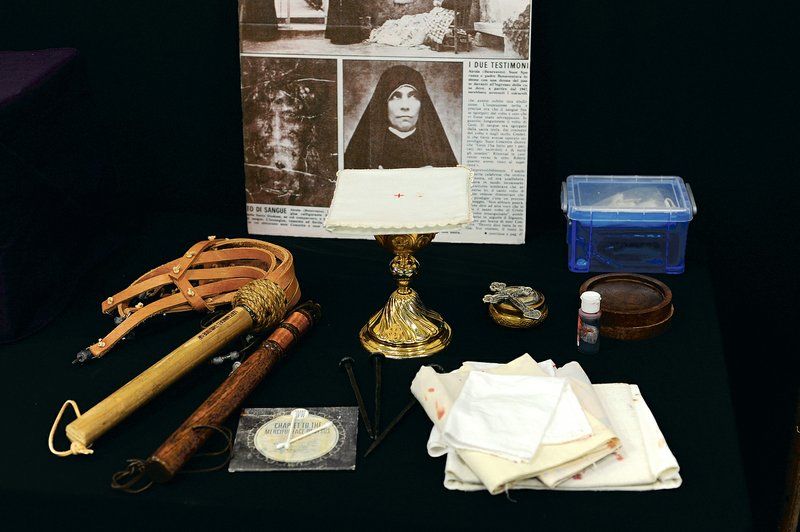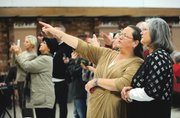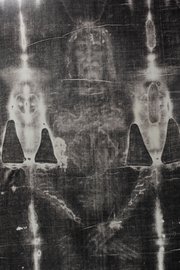The Apostle Thomas doubted the Resurrection of Jesus until Jesus appeared to the apostles and instructed Thomas to touch the wounds left in Jesus' hands by the nails that pinned him to the cross.
"'My Lord, my God!' Thomas shouted," said Donald Nohs. "And he believed."
Nohs too is a believer. The director general of the Confraternity of the Passion International and president of the Holy Face of Jesus Association, Nohs believes the Shroud of Turin is the authentic and true burial cloth of Jesus, left in the tomb in Jerusalem at the Lord's resurrection. Nohs shared his beliefs Jan. 16 at St. Joseph Catholic Church in Tontitown.
But just as Thomas doubted, some doubt the authenticity of the cloth said to be the shroud wrapping the body just a few days before Thomas encountered the resurrected Jesus. The shroud is now preserved in the royal chapel of the Cathedral of St. John the Baptist in Turin, Italy.
Carbon dating in 1988 put the cloth's origin in the Middle Ages, between 1260 and 1390, about the time of the shroud's first exhibition in 1357 in France.
During the 1970s, the Roman Catholic Church encouraged study of the cloth and sanctioned the Shroud of Turin Research Project, a group of about 30 scientists charged with examining the cloth, Nohs explained.
"We can conclude for now that the Shroud image is that of a real human form of a scourged, crucified man. It is not the product of an artist," reads the final report of the group in 1981. "The blood stains are composed of hemoglobin and also give a positive test for serum albumin. The image is an ongoing mystery, and until further chemical studies are made -- perhaps by this group of scientists, or perhaps by some scientists in the future -- the problem remains unsolved."
More recent studies have shown that dirt particles on the shroud are identical to those found in ancient tombs of limestone used for Jewish burials, the blood stains have been typed to AB, and DNA of plant materials comes from plants native to the Mediterranean countries, the Middle East and other areas around the globe.
Nohs displayed full-size copies of images taken by research project scientists, using aerospace technologies, during his local presentation, noting the details are more visible on the negative images of the cloth.
He said he has used those images as a study of the Passion of Jesus, putting them side by side with Gospel text.
"I've been studying the shroud for more than 50 years," Nohs told the Tontitown crowd, noting his fascination started in childhood. "It's the burial shroud of Jesus, the cloth placed on him. When he rose, the image was applied to the cloth."
He said he is not so much concerned with the "how" of the image as the scientists are, but rather the "why."
EMPTY TOMB
"History begins in John 20," Nohs stated. "John didn't find the body missing."
The gospel reads that the women rushed to tell John and Peter that Jesus' body was gone from the tomb. As the men entered the tomb, John, who was younger, stopped. He saw the linens in which Jesus had been wrapped, but he didn't enter.
"He knew there was something special about the cloths," Nohs continued. "He knew to not mess with them and to wait until authorities got there."
Peter entered the tomb first, and noticed the "napkin" that had been placed about Jesus' face was not with the rest of the linens.
The "napkin" is believed to be the Sudarium of Oviedo, a blood-stained piece of cloth preserved at the Camara Santa of the Cathedral of San Salvador in Oviedo, Spain. Nohs also showed an image of the sudarium.
"It had been folded and placed to the side by itself," Nohs said. "John's account never mentioned there was no body there, but he mentioned the napkin."
Seeing the body gone was the moment "John saw and believed," Nohs said. "But what did he see? What did he believe? That Jesus is the son of God -- not that he was resurrected, because they didn't understand yet he had risen from the dead."
John helped place the now-missing body in the tomb and converted to Christianity that "miraculous second in the sepulcher," Nohs said. But Peter was not affected, Nohs continued. "He was not at the burial. He said it didn't look like Jesus."
"John must have seen something awesome. It must be Jesus' image on the cloth," Nohs said.
JEWISH IDENTIFICATION
"But is this Jesus," Nohs asked his audience, pointing to his images.
The shroud is a rectangular piece of herringbone linen, measuring approximately 14-by-4 feet, Nohs began. A faint, brownish image of a front and back view of a naked man with his hands folded across his groin appears on the cloth -- although detail of the image is more visible on the negative views.
Because the Bible records Jesus as Jewish, researchers estimated the average height and weight of a Jewish man of the era. Jesus stood at 5 feet 10 or 11 inches, and his weight was about 175 pounds, Nohs related. And the Shroud of Turin would fit a body of that size, Nohs showed by draping a cloth with the same measurements on a local participant.
"Jesus was lean and well built," Nohs explained. "He worked as a carpenter. But a first-century carpenter was also a brick mason, so he worked doing physical labor."
The shroud also shows long side-locks -- like those still worn by some Orthodox Jews -- and a long ponytail, telling researchers the man was from Galilee, Nohs continued. And he pointed to markings that could be interpreted as evidence of a T'fillin, symbols worn by some Jews during daytime prayers and often carried by rabbis. "The blood flow shows seven breaks where the leather strap of the T'fillin was wrapped around his arm," Nohs explained.
Some debate the markings on the cloth of blood flow from the body's head, but, with his model, Nohs showed -- in both three-dimensional and flat demonstrations -- how the markings might have been made.
His presentation continued, pointing to marks on the imaging of wounds left by various beatings, flagellations, falls, thorns, splinters and even the holes left from first-century roofing nails used to hang Jesus on the cross.
"Jesus was in agony in the garden (of Gethsemane on the night of his arrest). What did Jesus think about being crucified on the human level," Nohs pondered. "The gospels say he knew he would be crucified. But he not want to die -- and certainly, he would rather die in any other way than this.
"He knew his best and closest friends would desert him," Nohs continued. "Peter said, 'I'll die with you,' but prophecy correctly predicted he would deny Jesus three times."
SUDARIUM STORY
Rabbi Robert Lennick, spiritual leader of Jewish Congregation Etz Chaim in Bentonville, confirmed covering of the body or wrapping it in a shroud would have been a practice in first-century Israel as it is today.
"Jews are to be buried in a simple linen shroud," Lennick said. "And some will cover the face of the dead at the time of death, so that no once can stare at the dead. It is the same reason we have only closed caskets and no wakes in Judaism -- out of respect for the dead.
"It is disrespectful to stare at someone in life -- and a person who is dead is still respected and treated as a person. While alive, a person can turn away from being stared at; while dead, they cannot. So we protect them in a sense, respect them -- by not being able to stare at them -- with a closed casket, and for some Jews, by covering the face right after death occurs."
Nohs returned his attention to the sudarium and its descendant, the corporal, a holy piece of cloth on which Catholic priests serve Holy Eucharist, as he demonstrated.
"One of the relics held by the cathedral in the town of Oviedo, in the north of Spain, is a piece of cloth measuring approximately 84 by 53 centimeters," reads shroud.com, the website of the Shroud of Turin Research Project. "There is no image on this cloth. Only stains are visible to the naked eye -- although more is visible under the microscope. The remarkable thing about this cloth is that both tradition and scientific studies claim that the cloth was used to cover and clean the face of Jesus after the crucifixion."
"With John 20, we know, that when Jesus died on the cross, they covered his face with a sudarium," Nohs noted. "From the sudarium (of Oviedo), we know the final position of Jesus' body on the cross -- with his head down and to the right." He again demonstrated with local participants, this time two young girls.
"The stains on the sudarium show that when the cloth was placed on the dead man's face, it was folded over, although not in the middle," the research site reads. "Counting both sides of the cloth, there is therefore a fourfold stain in a logical order of decreasing intensity.
"From the composition of the main stains, it is evident that the man whose face the Sudarium covered died in an upright position. ... The cloth was not wrapped entirely around the head, because the right cheek was almost touching the right shoulder," the report continues. "This suggests that the Sudarium was put into place while the body was still on the cross.
"The second stain was made about an hour later, when the body was taken down. The third stain was made when the body was lifted from the ground about 45 minutes later. The body was lying at the foot of the cross for about 45 minutes before being buried."
The scientists continued their study with the composition of the stains, which proved to be blood and fluid from "pleural oedema"-- the liquid that collects in the lungs when a crucified person dies of asphyxiation, the report reads. If the body is jolted, the fluid can come out through the nose.
Jewish tradition states that the body must be preserved in its entirety -- the body and its fluids, Nohs said. No doubt someone was sitting below Jesus to receive his blood in a basin so as to keep the wholeness of the body intact, he added.
The scientists were presented with the napkin left in folds, Nohs said. "At the end of John 20, the napkin is still in folds, sitting by itself," probably placed there before the body was wrapped in the shroud.
(When Peter entered the tomb), he saw the strips of linen lying there, as well as the cloth that had been wrapped around Jesus' head. The cloth was folded up by itself, separate from the linen.
-- John 20: 6-7
"It is so important that John tells us (the sudarium) was off his face," Nohs implores. "If John tells us it was still on the face of Jesus when he was resurrected -- as was typical ... If it's still on the face of Jesus, there's no face on the shroud.
"At the end of John 20, 'The napkin is still in folds in a place by itself.' That reveals the message of the Holy Shroud, the message that John knew to write."
Nohs related the Jewish tradition of a master and servant at a meal.
"If the master is called away, he puts his napkin in folds on his chair, letting the servant know he is coming back. Otherwise, he will crinkle the napkin and place it on the plate, saying he is finished and not coming back and the plate can be removed," Nohs concludes the tale.
"John tells us the napkin -- Jesus' napkin -- is still in folds. It says, 'I'm coming back.' What a powerful message for us."
NAN Religion on 01/30/2016




